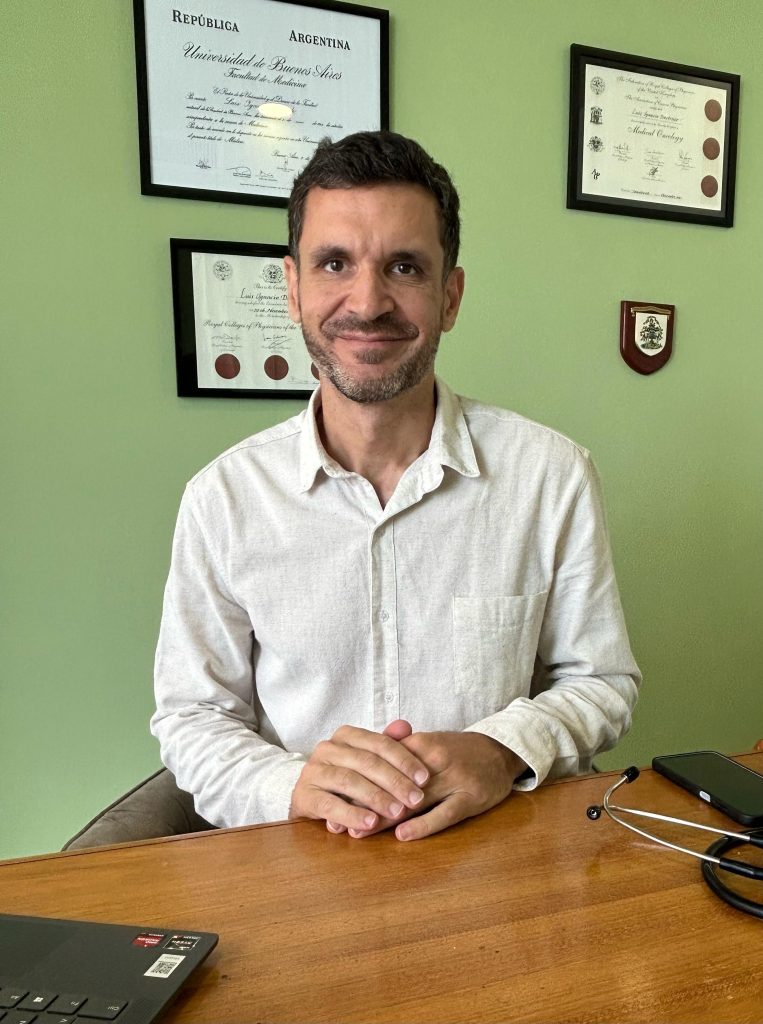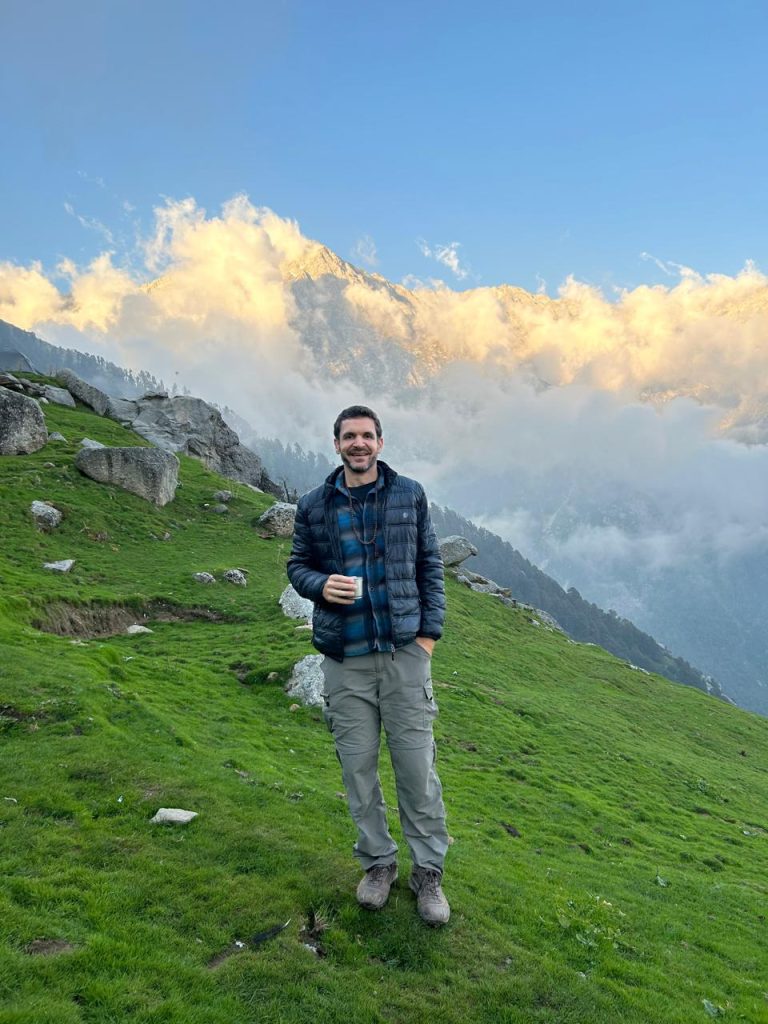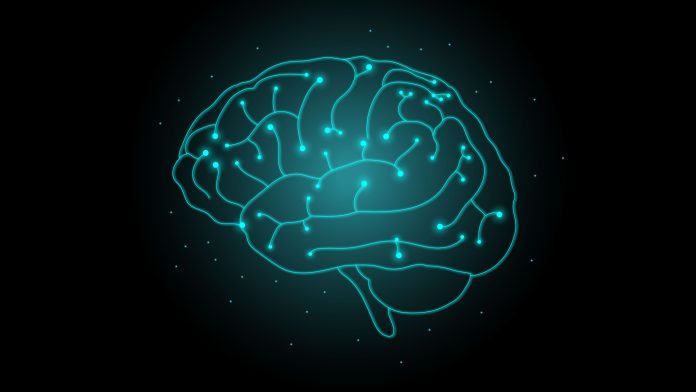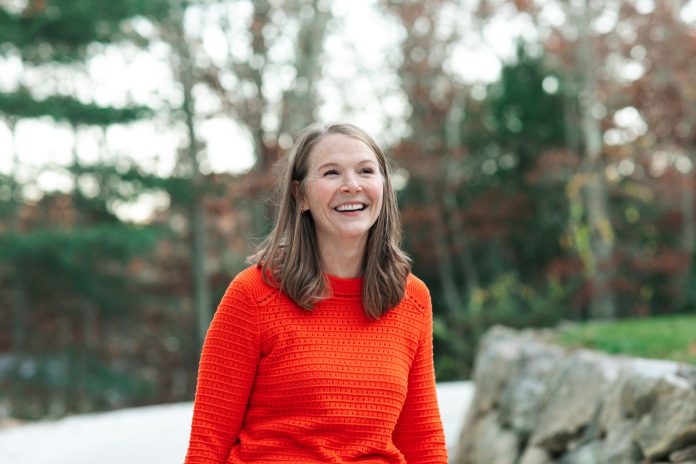Interview by Sofia Campos Caminos

Dr. Luis Daverede began his medical journey deeply rooted in conventional Western medicine. A graduate of the University of Buenos Aires, he went on to complete his residency and specialist training in internal medicine and clinical oncology in the United Kingdom at top institutions such as Queen Elizabeth Hospital (London), Addenbrooke’s Hospital (Cambridge), and St. James’s University Hospital—one of the largest oncology centers in Europe.
Over the course of his career, he has served as an oncologist in both Argentina and the UK, worked as a breast cancer advisor for Novartis Oncology, participated in more than 30 clinical trials, and received international recognition for his research, including a High Commendation Award from the UK’s National Cancer Intelligence Network.
Despite his deep roots in evidence-based medicine, Dr. Daverede eventually found that Western conventional medicine was missing an essential aspect of healing: the connection between mind, body, and soul, as well as valuable knowledge of ancient medicine.
Today, he embraces an integrative, human-centered model of care that bridges science and spirituality. Drawing from fields such as Ayurveda and psychoneuroimmunoendocrinology (PNIE), he focuses on prevention, emotional balance, and the profound connection between energy and healing.
In this insightful conversation with Simple People, Dr. Daverede shares how his journey—from high-level oncology to holistic medicine—revealed the importance of treating the whole person: mind, body, and spirit.
SIMPLE PEOPLE: It’s really special to be able to talk to you. Our mission in Simple People includes giving people actionable advice about their well-being and empowering them. I know that you have a very interesting holistic approach with +20 years of experience as an oncologist in traditional and very prestigious hospitals, lately focusing on a more holistic approach.
LUIS DAVEREDE: I really love what you do, and I think it’s really important to communicate all these new holistic approaches of medicine, especially in Western medicine. A lot of people are really learning about this thanks to the new ways they now have to investigate and learn more about holistic medicine.
SP: How did you come to realize that there was something missing in the approach taken by conventional medicine?
LD: Well, that’s an excellent question. I think my path was probably very gradual because I’ve always had an interest in yoga, since my teenage years. I became ill when I was around 16 years old. I had a peptic ulcer in my stomach, which bled. I wasn’t doing very well at that time. I think my holistic journey may have started with my own illness. I had relatives—particularly an aunt—who helped me a lot with yoga, which really supported my healing process. I also explored different types of psychotherapy. By the time I started medical school at the University of Buenos Aires, which is a very traditional institution, I found that there was no focus on the connection between mind, body, and soul. The [type of] education was very scientific and rigid, with no recognition of the potential benefits of spiritual healing or mental well-being. There was only one small [subject] on mental health, taught for just a few months, which is a real shame.
After medical school, I had the opportunity to travel to England. I started in Canada first, spending four months at Toronto Western Hospital, and then moved to England to complete all my postgraduate training in internal medicine and oncology. Throughout that time, I kept practicing yoga and learning more about it, which has always been very important to me. Yoga really helped me cope with the stress of medical training. As you can probably imagine, residency is an extremely stressful period of life, with on-call shifts, long hours, and a lot of responsibility, especially when you’re still learning. Yoga and its philosophy helped me manage all that stress. It’s more than just an exercise routine—it’s a way of life.
During my time in England, I met many doctors from around the world. England—especially London—is very cosmopolitan, and I lived in various cities, including Norwich and Leeds. I met doctors from China, Southeast Asia, and India. While they all practiced conventional medicine, they taught me a lot about their own traditions, including traditional Chinese medicine and Tibetan medicine, which I found fascinating. I started reading more about these practices, but I continued working in university hospitals. When I returned to Buenos Aires, I worked at a large university hospital and kept practicing [conventional] medicine. However, about five years ago, I began to realize that Western medicine was missing an important piece, especially in areas like mental health and spirituality, as well as many valuable aspects of ancient medicines—especially those from the East, [or] traditional medicines from America.
I started diving deeper into these topics and had the chance to meet a very knowledgeable, holistic and integrative oncologist, Maria Laura Nasi. […] She introduced me to the idea of integrating ancient medicines and spirituality—mind, body, and spirit—into conventional medicine. What I realized is that there’s so much more we can offer patients going through illnesses with conventional treatments.
One of the things I struggled with in university hospitals was the existential crisis and anguish that many patients experience during their illness. I felt frustrated because these deeply human aspects weren’t being addressed. I wanted to help them more, offering a holistic approach to healing.
So, I began training in various areas. I did a diploma in psychoneuroimmunoendocrinology (PNEI), which was incredibly interesting because there’s scientific evidence supporting the mind-body connection. We know that emotional states can impact the body and that the body can affect the mind. For example, we understand how gut flora influences serotonin production, which plays a key role in well-being and happiness. This diploma sparked my interest further, and I then began studying Ayurveda, a traditional Indian medicine that’s been practiced for over 5,000 years. I did postgraduate training in Ayurveda, and it truly fascinated me because it provided many of the answers I was looking for.
Ayurveda is a medicine that not only takes into account the physical body but also the energetic body. It talks about prana and agni—the energy we need to live, as well as the energy needed to digest not just food but also thoughts and life’s challenges. How do we digest trauma? How do we digest grief? Ayurveda began providing answers to these questions. At one point, I decided to finally leave the hospital and start my own private consultancy, a great leap. I started practicing a medicine I’m truly convinced about. Of course, I never left science behind, and I’m also pursuing post-graduate training in integrative medicine in Barcelona. It’s a fascinating course that teaches functional medicine and other types of medicine, including aspects of Chinese medicine.
I began incorporating a lot of ancient medicines into my practice, like adaptogenic fungi, plants, and cannabis. By blending these with conventional medicine, I realized we could reduce the need for many pharmaceutical treatments.
It’s unfortunate that the pharmaceutical industry has suppressed many plant-based and fungi-based therapies, but there’s a big resurgence of ancient medicines, especially in Western culture, and that’s truly amazing.
SP: How can people approach their well-being in an integrative way, considering spirituality, energy, intuition, and the connection between body, mind, and soul—without waiting until they get sick? How can people begin today, even if they don’t have any symptoms?
LD: That’s very important. Prevention is key—always staying one step ahead of illness. Ayurveda […] emphasizes the prevention of illness and how to begin the process of self-healing. Ayurveda speaks of the different layers of our being.
We have our physical body, which can be examined under a microscope, with blood tests and cholesterol levels, for example. But we must recognize that, while we have objective evidence of the physical body, it will be influenced by stress or emotions. For instance, a high cholesterol level might be a result of stress, not only poor nutrition. This is where a holistic approach begins—we understand that mind, body, and spirit cannot be separated. They are interconnected.
We have the physical body, and we also have the energetic body. Finding balance in our energetic body is essential. We need to assess how balanced our masculine and feminine energy is and how balanced our seven chakras are. Are they flowing properly, or is there a blockage in one of them? Why is that?
Energy is what sustains us. It is vital; it keeps us healthy. We need to monitor our energy levels and how balanced they are. To do this, we must engage in introspection and self-analysis. Health is a process that starts from within and extends to other aspects of life. But it always begins with the self. […] We must ensure that we’re not living on autopilot. We need to connect mind and body. It is essential to take a few minutes each day to reflect, “How am I doing? How is my energy? How are my feelings? How is my soul?” We need to ask ourselves, “Am I living according to my core values, or am I drifting away from them?”
We should continuously check in with ourselves to ensure our energy is flowing. […] Within the energetic body, we have our mind, thoughts, memories, behaviors, and habits. A balanced and healthy mind is crucial, and we must recognize that we are not our mind—it is just one aspect of our being, and we should not be trapped by it.
Caring for our mind is a vital tool for our well-being. If we struggle with negative thoughts, memories, anxiety, or depression, it’s important to seek help. It is crucial to seek assistance without immediately reaching for a pill. One issue with modern society is that, at the first sign of mental health concerns, we tend to take medication—such as benzodiazepines or antidepressants—without considering why we have arrived at this point. Introspection is key to understanding what’s happening in our lives.
Our emotional world is another important aspect of our being. We must seek peace and well-being by evaluating how we are experiencing unconditional love. […] How can we achieve emotional balance? Are we allowing ourselves the space to feel our emotions? Are we managing them? In our society, we often suppress emotions, particularly in work or family environments where showing emotion is not accepted. We hide them, suppress them, and that can be dangerous.
It’s crucial not only to look after our mental health but also our emotional health. We must be aware of our emotions. How are we emotionally? How is our fear? How is our experience of unconditional love? These are the two primary emotions. It’s important to make space for them, because if we do, we are less likely to experience illness. We won’t allow these emotions to escalate.
Regarding emotional health, you also mentioned intuition. Intuition is the ability to perceive beyond the physical world. This ability has been largely suppressed in Western culture. We often see intuition as just a feeling or a hunch, but we don’t pay enough attention to it. Science and Western medicine don’t focus enough on it. However, it’s fascinating because many brilliant individuals, like Albert Einstein, spoke about how intuition helped them develop their theories. He had intuition about these things. He felt something about mass and energy, speed of light—and he had all this intuition that helped him reach a lot of his wisdom.
Intuition is essentially our inner voice. It’s the part of us that says, “Something isn’t right. I don’t feel well. Something is off, and I need to pay attention to this because it might escalate into illness.” I’m fortunate to have many patients who are connecting with that inner voice. They come to see me because they feel their energy isn’t right—they feel drained, like they’re running on half a battery. They struggle to get through the day, sensing that something is wrong. And, more often than not, we uncover something physical, a tangible issue that we can help resolve.
We tend not to trust our intuition, but I trust mine deeply. Intuition is a form of energetic wisdom. It’s not always clear where it comes from, but there are many times when I arrive at a diagnosis or solution and I’m not entirely sure how I reached it. I just feel I can trust my intuition—that inner voice guiding me.
The key to unlocking our intuition, what we call the “third eye,” is meditation. Why is our intuition sometimes blocked? It’s because there’s so much going on in our minds—so many thoughts, problems, worries. Imagine it like a large water tank filled with mud. It’s cloudy, and you can’t see clearly. But when you calm yourself, when you meditate, the dust begins to settle. The water clears, and suddenly, you can see more clearly. You can connect with deeper insights. This is the power of meditation, of clearing the mind to allow intuition to flow freely.
Unfortunately, we often normalize symptoms, especially in our busy lives. We push through migraines, digestive issues, or persistent aches without addressing the root cause. We might say, “Oh, I’m just always constipated,” or “My back aches, but it’s just something I have to live with.” Over time, we don’t realize that these symptoms are our bodies speaking to us, telling us that something is wrong. […]
We often ignore these messages, failing to recognize that our body is trying to communicate with us, that it’s not aligned with our core values or that unresolved trauma is still affecting us. Perhaps it’s a childhood trauma that we never healed, a wound that was never addressed. Energetically, everything that happens to us remains within us—nothing disappears. But if we take the time to process and heal, especially those past wounds, we can restore balance and wellness. Giving ourselves the space and time to heal is incredibly important.
SP: So it’s also about the energy getting stuck in parts of our being, because we don’t acknowledge it, we don’t treat it, we don’t process it. It gets trapped in the body, which can then show up as physical symptoms. So anything we can do to bring light to those unresolved issues, to understand and process them, will help release that energy and allow it to flow freely again?
LD: Exactly. Think of trauma as an open wound. When we experience something traumatic, it’s like a break or separation at an emotional level. Trauma, as defined in Latin, means “breakage” or “separation.” Just as a physical injury creates a fracture, emotional or energetic trauma causes a separation—mind and body disconnect as a defense mechanism. We disconnect from the experience because, as children, we don’t have the emotional tools to cope. If our parents lacked emotional education or had their own traumas, we never learn how to process or address the trauma. Instead, we bury it, and that wound remains open.
One of my major influences, Dr. Gabor Maté, speaks about this separation between mind and body as a defense mechanism. He explains that when we lack the emotional tools to deal with trauma, we disconnect from the emotional pain to survive. This disconnection creates a wound that doesn’t heal. As adults, we have the ability and responsibility to take action, to seek help, and to find the tools to heal. We can take steps to heal, to reconnect mind and body, and to close that wound.
How do we heal trauma? How do we close that wound and integrate mind and body?There are many tools available for healing today. One positive aspect of modern times is that, thanks to social media and the widespread sharing of valuable information, people are beginning to realize that we have access to tools that can heal us. This is incredibly important. We have methods like EMDR, TFT, various new psychotherapies, and family constellations—techniques that can aid in healing. And healing doesn’t necessarily mean reliving the trauma; it can be done in a very compassionate way. If you explore Gabor Maté’s work, you’ll find it’s based on what he calls “compassionate inquiry.” Compassion is key in helping a person heal and revisit their trauma in a loving and supportive environment.
Techniques like EMDR (Eye Movement Desensitization and Reprocessing), for example, which is a neuropsychological method, are highly effective. Although it has been around for some time, it’s relatively new compared to psychoanalysis. In just a few sessions, methods like EMDR can help improve and heal trauma. There is growing scientific evidence showing the connection between emotional well-being and physical health.
With my 20 years of experience as a physician, I can confidently say that the connection between emotions and illness is undeniable. It’s impossible to separate the two. Many physical illnesses, particularly cancer and autoimmune diseases, are linked to unresolved trauma or difficult emotional experiences.
We need to heal. My message to the audience is this: if you feel you haven’t healed from trauma, or if you are struggling emotionally or with your mental health, please seek help. Don’t wait for illness to become the catalyst for your healing.
Unfortunately, that’s often what happens. People develop complex or autoimmune illnesses as a wake-up call—something that forces them to confront their trauma because their life or quality of life is at risk. That’s when they begin their healing journey. There’s a lot of healing potential available today.
In my practice, I’ve noticed that women tend to seek help sooner and are more open to connecting with their past and exploring the mind-body connection. Men, on the other hand, tend to struggle more with this. We all have the same capacity for emotional awareness, but culturally, there’s still a lot of work to be done on the emotional well-being of men. Due to societal expectations and limiting beliefs, men have traditionally been discouraged from connecting with their emotions. The message they received was, “Be strong, keep going, don’t show vulnerability.” This has had a significant impact on men’s emotional health.
A lot of the violence we see from men toward women can be traced back to the inability to process or connect with emotions. Unfortunately, men have not been given permission to cry, to show vulnerability, or to express their emotional side. However, things are changing culturally, and younger generations feel more empowered to express their emotions compared to previous generations.
SP: Maybe we can wrap up by talking about the connection between emotions and healing. I know you’re a big fan of Gabor Maté and his “seven pillars of healing.” Can you share more about those pillars and their connection to emotions, along with any final thoughts you’d like to add?
LD: My message is this: healing requires a lot of love, but that love must come from within. One of the major reasons people become ill is because they don’t love themselves enough. They lack self-esteem and fail to recognize their own powerful self-healing potential. The pillars of healing are self-love, letting go of blockages, and releasing things that are blocking our path. For example, if we harbor hatred toward someone, or if we need to forgive someone, it’s crucial to release that energy. We must also forgive ourselves.
Forgiveness is a vital part of healing. We cannot heal if our hearts remain closed. If we don’t allow unconditional love into the healing process, it becomes very difficult. Unconditional love means forgiving those who have hurt us. By forgiving someone, we also forgive ourselves and initiate our own healing. Often, people who have hurt us are acting out of their own unhealed wounds. If we understand this, it becomes easier to forgive. For instance, if a parent caused us pain, it was likely because they were struggling with their own unhealed wounds, even if they were doing the best they could.
Healing is rooted in love, forgiveness, and understanding our own potential. It’s about achieving a vibrational state that supports healing. There is no magic pill or treatment; while physical treatments help, we need to cultivate a state of love and faith in ourselves.
As Joe Dispenza frequently emphasizes, we must find a vibrational state that aligns with love and faith. Without faith in ourselves, healing becomes incredibly difficult. To heal our wounds, we need self-compassion. We must recognize that whatever decisions we made in life, we made them with the best intentions at the time.
Many people struggle with guilt during the healing process, but guilt is a major roadblock. If you smoked, were overweight, or made unhealthy choices, it’s important to make peace with yourself. Healing doesn’t involve guilt; it’s about loving yourself enough to make better choices going forward. A healing journey should be one of love and compassion, not a path of suffering and sacrifice. It’s a beautiful path of redemption, letting go, and reconnecting with nature and others in a deeper way.
Many of my patients have told me that their illness was the best thing that ever happened to them, because it led them to a spiritual awakening and a stronger connection with nature. We often lose touch with nature—we live in buildings, have low vitamin D levels, and are disconnected from the cycles of the moon, which are important, especially for women whose hormonal cycles align with lunar cycles.
We also lose touch with plants and animals, and this disconnection hinders our healing. Nature is where we come from, and it’s an essential part of our well-being. We can’t separate ourselves from nature, just as we can’t separate mind and body. Healing often comes from reconnecting with nature and embracing the gifts that plants and fungi offer.
SP: That’s beautiful—like returning to yourself and to your roots, where the answers lie. It was such a pleasure speaking with you.






